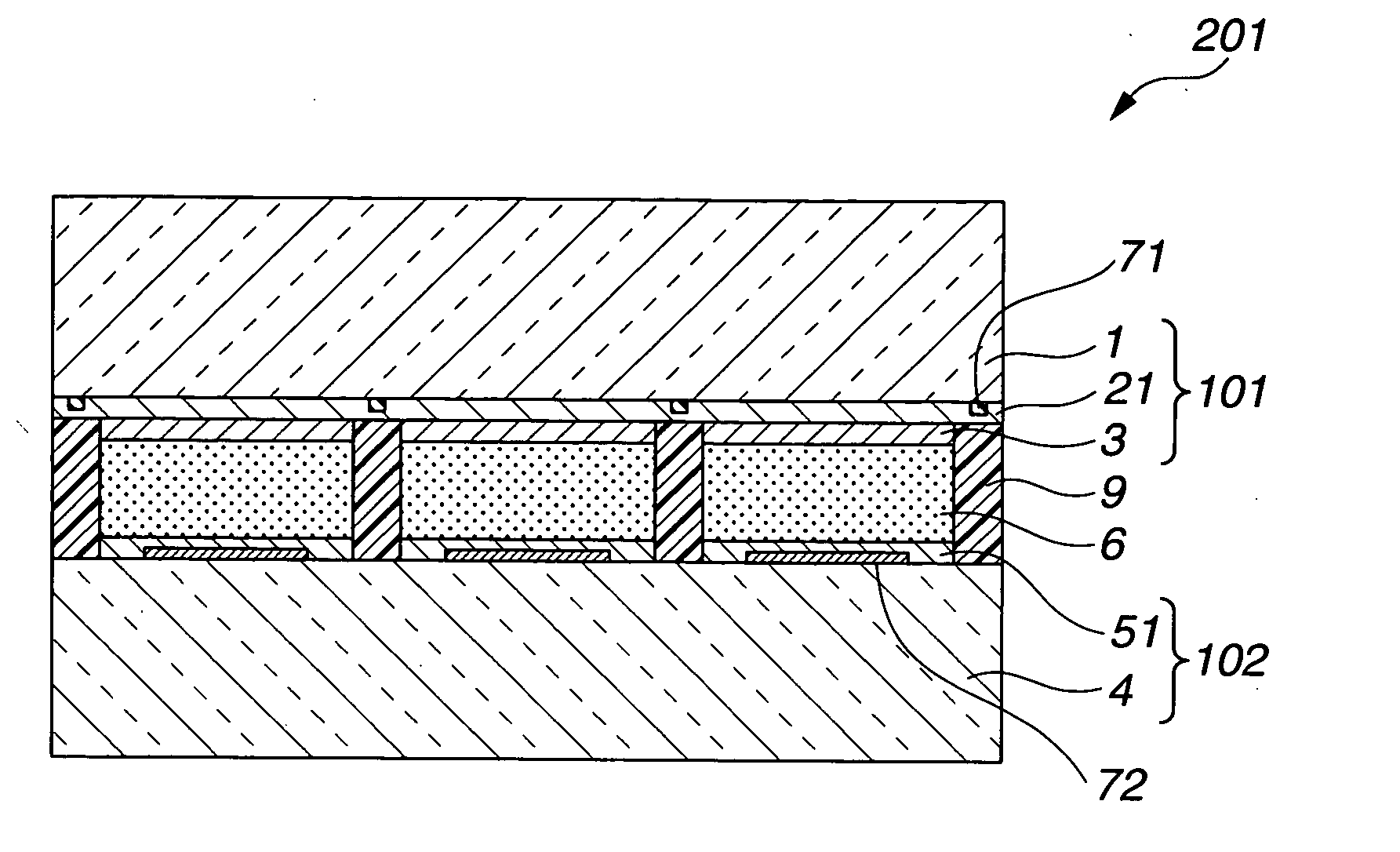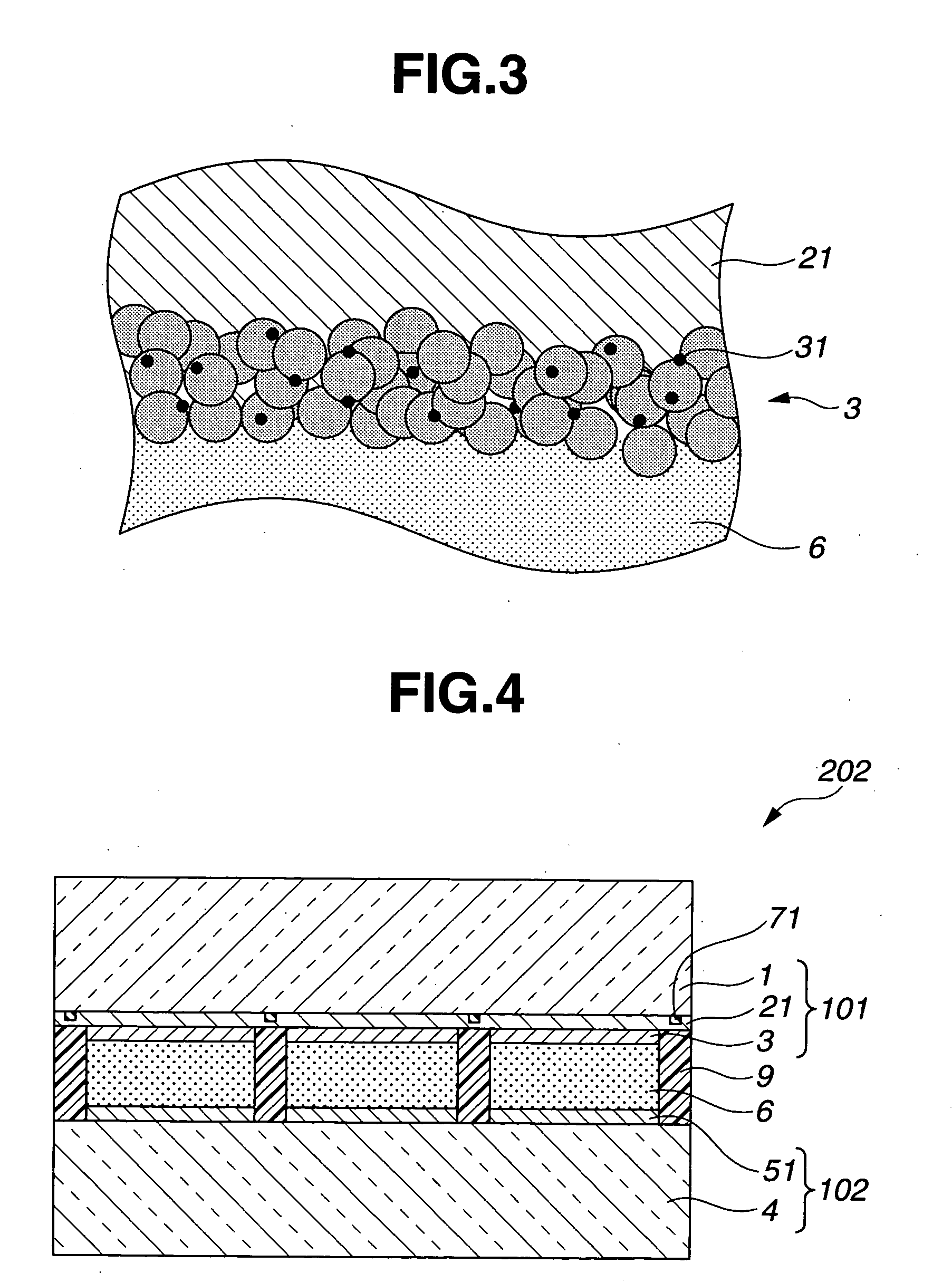Dye-sensitized solar cell
a solar cell, dye-sensitive technology, applied in the direction of light-sensitive devices, electrolytic capacitors, electrochemical generators, etc., can solve the problems of collector electrode corrosion and separation, high material processing energy costs, internal resistance increase, etc., to prevent the corrosion of collector electrodes, high corrosion resistance, sufficient photoelectric conversion efficiency
- Summary
- Abstract
- Description
- Claims
- Application Information
AI Technical Summary
Benefits of technology
Problems solved by technology
Method used
Image
Examples
example 1
[0119] A dye-sensitized solar cell 201 shown in FIGS. 1-3 was manufactured by the following procedure.
[0120] (1) Production of First Base Member 101
[0121] A glass substrate having a length of 100 mm, a width of 100 mm and a thickness of 1 mm was prepared as a light-transmitting substrate 1. A first collector electrode 71 was formed with a width of 1 mm and a thickness of 1 μm on a surface of the substrate 1 by RF sputtering using tungsten (99.8 mass % pure) so as to surround three pieces of semiconductor electrode 3 to be provided in the later stage. After that, a light-transmitting conductive layer 21 of fluorine-doped tin oxide was formed by RF sputtering with a thickness of 500 nm on the surface of the substrate 1 to which the first collector electrode 71 had been applied. Then, three titanium electrode layers (as an electrode body) each having a length of 80 mm, a width of 27 mm and a thickness of 20 μm were formed by applying a paste containing titania particles of 10 to 20 μm...
example 2
[0128] A dye-sensitized solar cell 202 was manufactured by the same procedures as in Example 1, except that the solar cell 202 was provided with a first collector electrode 71 but not with a second collector electrode 72 as shown in FIG. 4. A performance evaluation was then conducted on the dye-sensitized solar cell 202 in the same manner as in Example 1. The solar cell 202 characteristically showed a conversion efficiency of 6.0% to achieve practically sufficient performance although it was slightly lower than that of Example 1.
example 3
[0129] A dye-sensitized solar cell 204 shown in FIG. 6 was manufactured by the following procedure. The appearance of the dye-sensitized solar cell 204, when viewed from the side of a resin substrate 1 of a first base member 101, was similar to that of Example 1 shown in FIG. 2.
[0130] (1) Production of First Base Member 101
[0131] A resin substrate of polyethylene terephthalate resin having a length of 100 mm, a width of 100 mm and a thickness of 1 mm was prepared as a light-transmitting substrate 1. Some pieces of tungsten wire of 20 μm in diameter (to be formed into a first collector electrode 71) were arranged on a surface of the resin substrate 1 in a parallel planar configuration. After that, the resin substrate 1 and the tungsten wire were heated together at 180° C. and formed by pressing them against each other with a pressing machine so as to apply a pressure uniformly in a planar direction and thereby embed about 90% of the tungsten wire, when viewed in cross section, into ...
PUM
| Property | Measurement | Unit |
|---|---|---|
| thickness | aaaaa | aaaaa |
| thickness | aaaaa | aaaaa |
| thickness | aaaaa | aaaaa |
Abstract
Description
Claims
Application Information
 Login to View More
Login to View More - R&D
- Intellectual Property
- Life Sciences
- Materials
- Tech Scout
- Unparalleled Data Quality
- Higher Quality Content
- 60% Fewer Hallucinations
Browse by: Latest US Patents, China's latest patents, Technical Efficacy Thesaurus, Application Domain, Technology Topic, Popular Technical Reports.
© 2025 PatSnap. All rights reserved.Legal|Privacy policy|Modern Slavery Act Transparency Statement|Sitemap|About US| Contact US: help@patsnap.com



